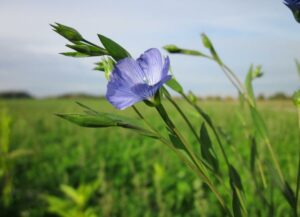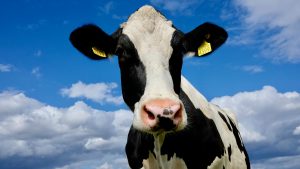Alvaro Garcia
It is currently accepted that acetate produced from fiber fermentation in the rumen, supplies nearly 40% of the building blocks for de-novo milk fatty acid synthesis in the mammary gland. Of the remaining milk fat, 10 % comes from circulating fatty acids mobilized from fat stores, and 50% coming arises from the diet.
Dietary phospholipids have health-promoting effects in humans such as inhibition of colorectal cancer, reduce the prevalence of gastric ulcers, and decrease the absorption of cholesterol. The latter likely results from the physical intestinal interaction between phospholipids and cholesterol, decreasing the absorption of both.
The fatty acid (FA) composition of phospholipids influences this bonding since their long-chain saturated FA interact more strongly with cholesterol than the unsaturated form. These phospholipids are in the milk fat globule membrane and dairy products rich in this membrane (i.e. buttermilk) are good sources of these phospholipids.
Dairy cows’ milk fat has 0.2 to 1% phospholipids with sphingomyelin constituting approximately 20% of them. Since sphingomyelin has a high proportion of long-chain saturated FA, this allows for a better interaction with cholesterol. These strong sphingomyelin-cholesterol bonding is essential for cell function. They are also present in the milk fat globule membrane, suggesting that this complex may play a role in the hydrolysis and absorption of milk fat by the calf.
Not much research has been conducted to examine the effects of lipid supplementation on FA composition of phospholipids, and their proportion. It has been reported that higher unsaturated FA supplementation increased the proportion of unsaturated FA in milk phospholipids. No research has been conducted in fat-supplemented cows to assess the composition of milk sphingomyelin or the mammary transcription of genes regulating its de novo synthesis.
It is likely that the FA composition of sphingomyelin in cow’s milk is regulated more closely than that of phospholipids. A strict regulation of the FA composition may have a role in the transcriptional regulation of enzymes involved in sphingomyelin de novo synthesis. Several enzymes catalyze this synthesis such as serine palmitoyl transferase, long-chain subunits 1 and 2, and the longevity assurance gene 1 homolog-ceramid synthase 2.
This last enzyme catalyzes the formation of ceramid, the sphingolipid starting unit. The UDP-glucose ceramide glycosyltransferase participates in the formation of glycosphingolipids from ceramide. According to research serine palmitoyl transferase, long-chain subunits 1 and 2 are rate-limiting factors in sphingomyelin synthesis and are regulated transcriptionally and post-transcriptionally.
A recent study (S. Lashkari et al. 2020) evaluated the effects of crushed sunflower seeds supplementation to dairy cows on the FA composition of phospholipids, particularly sphingomyelin, and the mammary transcription of genes involved in the sphingomyelin de novo synthesis.
Holstein Friesian cows with 186 ± 20 DIM, and milk yield of 25.3 ± 2.5 kg/d were used in this experiment, blocked by days in milk within parity. All cows were initially fed a pre-experimental basal diet similar to the control. On the last day of this pre-experimental period, milk production and milk samples were obtained for fat analysis. Four diets were fed for 5 weeks as follows:
- Diet without sunflower supplement (control)
- Diet + crushed sunflower seed at 5% of DM
- Diet + crushed sunflower seed at 10% of DM
- Diet + crushed sunflower seed at 15% of DM
Effects of feeding sunflower seeds on milk fatty acids composition
Dry matter intake linearly decreased with sunflower supplementation (18.4, 17.3, 14.5, and 14.8 kg/d in control and 5, 10, and 15% sunflowers, respectively. Daily milk yield also decreased linearly with sunflower supplementation (29.0, 27.6, 20.9, and 20.9 kg/day for control and 5, 10, and 15% sunflowers, respectively).
The proportion of unsaturated FA in milk increased linearly with sunflower supplementation and was 27.5, 32.5, 40.2, and 40.30 (g/100 g of milk FA) in control and 5, 10, and 15% sunflowers. Milk fat content increased with sunflower supplementation. Phospholipid concentration in milk fat decreased with increasing sunflower supplementation, while sphingomyelin concentration was not affected. Phospholipid yield decreased linearly as a result of the decrease in milk yield. Sphingomyelin concentration increased with sunflower supplementation, while sphingomyelin yield was not affected.
The proportion of C16:0 incorporated in phospholipids decreased with sunflower supplementation. The proportion of monounsaturated FA in phospholipids increased with sunflower supplementation with the major contributing FA being C18:1 (n-9 cis); other monounsaturated FA that also increased were C20:1 (n-9 cis), C18:1 (n-9 trans), and C18:1 (trans-11).
The proportion of short chained FA in phospholipids decreased, which also caused a decrease in C16:0, C15:0, C14:0, and C12:0. The short chain FA proportion of sphingomyelin increased with sunflower supplementation. However, the unsaturated FA composition of milk sphingomyelin only allowed for a minor structural change in the sphingomyelin. Mammary transcription of the gene that coded the rate-limiting enzyme for sphingomyelin de novo synthesis decreased with sunflower supplementation.
In summary, sunflower supplementation increased the proportion of monounsaturated FA in milk phospholipids. The major isomer observed into these phospholipids was C18:1 (n-9 cis), which increased with sunflower supplementation. The C22:0 in sphingomyelin increased with sunflower supplementation constituting between 15.2 to 25.4% of total FA in sphingomyelin.
The data showed that dietary supplementation with sunflowers increased the proportion of unsaturated FA and monounsaturated FA in milk phospholipids with no effect on phospholipid concentrations.
Sunflower supplementation decreased n-3 PUFA proportion in sphingomyelin. These results suggested that mammary transcription of genes for sphingomyelin de novo synthesis is regulated by lipid supplementation.
Reference
S. Lashkari, J.W. Moller, S.K. Jensen, L.I. Hellgren, M.T. Sørensen, P.K. Theil, K. Sejrsen. Fatty acid profile of phospholipids and sphingomyelin in milk and regulation of sphingomyelin synthesis of mammary glands in cows receiving increasing levels of crushed sunflower seeds. Journal of Dairy Science, Volume 103, Issue 3, March 2020, Pages 2255-2263.
© 2020 Dairy Knowledge Center. All Rights Reserved.











